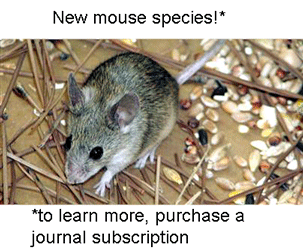Limited access limits taxonomy
 Good news for taxonomic science: “New type of mouse discovered in Cyprus” today made headlines on 193 sites around the world including BBC, Reuters, CNN, ABC, NBC, Fox News, International Herald Tribune, and Associated Press among others. According to the press release from the researchers at University of Durham, UK, “genetic tests confirmed that the new mouse was of a different species”, suggesting once again that, theoretical protests aside, in practice many taxonomists embrace DNA-based “species discovery” as well as DNA-based “species identification”.
Good news for taxonomic science: “New type of mouse discovered in Cyprus” today made headlines on 193 sites around the world including BBC, Reuters, CNN, ABC, NBC, Fox News, International Herald Tribune, and Associated Press among others. According to the press release from the researchers at University of Durham, UK, “genetic tests confirmed that the new mouse was of a different species”, suggesting once again that, theoretical protests aside, in practice many taxonomists embrace DNA-based “species discovery” as well as DNA-based “species identification”.
Bad news for taxonomic science: To learn more about what the researchers discovered, you have to purchase a journal subscription.
The press coverage of this article demonstrates discovery of new species is of wide public interest, and there are many persons who would want to read beyond the headlines. As it stands, readership is often limited to a small number of specialists, guaranteeing continuing obscurity for taxonomic science. Open access for new species descriptions could help increase visibility and willingness to fund taxonomic science.
This entry was posted on Thursday, October 12th, 2006 at 10:32 pm and is filed under General. You can follow any responses to this entry through the RSS 2.0 feed. Both comments and pings are currently closed.
October 13th, 2006 at 7:19 pm
Taxonomy and open access
As you may have heard, it was announced yesterday that a new species of mouse has been discovered in Cyprus. According to Mark Stoeckle at the Barcode blog (part of the Barcode of Life project), this was good news for taxonomic science because it R…